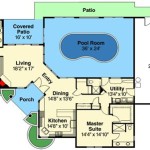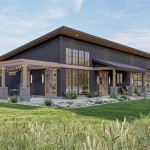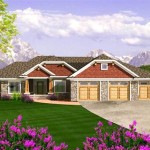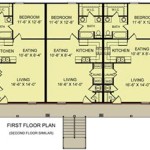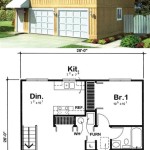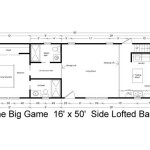Plans For A Garage With Apartment: Maximizing Space and Functionality
A garage with an apartment, often referred to as an Accessory Dwelling Unit (ADU) above a garage, presents a versatile solution for homeowners seeking additional living space, rental income opportunities, or accommodation for family members. Careful planning is crucial to ensuring the project meets building codes, maximizes functionality, and aligns with the homeowner's specific needs and budget. Numerous factors must be considered, from initial design and permitting to construction and finishing touches. This article explores key aspects of planning a garage with apartment, offering a comprehensive overview of the process.
Design Considerations and Space Planning
The design phase is perhaps the most critical aspect of planning a garage with an apartment. It involves determining the size and layout of both the garage and the apartment, considering the intended use of each space, and ensuring compliance with local zoning regulations. Zoning regulations often dictate setbacks, height restrictions, and allowable square footage for ADUs. Before any design work begins, it is essential to consult with the local planning department to understand these requirements.
The size of the garage will largely depend on the number of vehicles to be accommodated and any storage needs. Standard garage dimensions typically range from 12 feet wide for a single-car garage to 24 feet wide for a two-car garage. The depth of the garage should be at least 20 feet to comfortably park most vehicles. Consider adding extra depth for workspace or storage if desired.
The apartment's layout should be designed to maximize space and functionality. Key considerations include the number of bedrooms and bathrooms, the size of the living area and kitchen, and the placement of windows and doors for natural light and ventilation. Common layouts include open-concept designs that combine the living room, dining area, and kitchen into a single, spacious area. This layout is particularly effective for smaller apartments. Separate bedrooms and bathrooms provide privacy and comfort for occupants.
Accessibility is another critical design consideration. If the apartment is intended for an elderly relative or someone with mobility issues, it is important to incorporate universal design principles. This may include wider doorways, ramps instead of stairs, grab bars in the bathroom, and adjustable-height countertops. Even if accessibility is not currently a concern, incorporating these features can increase the long-term usability and value of the apartment.
Regarding the entrance to the apartment, several options exist. A separate exterior staircase leading to the apartment is the most common approach, providing privacy for both the homeowner and the apartment occupant. Alternatively, an interior staircase within the garage can be used, but this may require modifications to the garage layout and can reduce the available garage space. Another option is a side entrance if the garage is situated on a sloped lot. The best approach will depend on the specific site conditions and the homeowner's preferences.
Finally, think about the location of utilities. Plumbing and electrical systems must be carefully planned and installed to meet code requirements and ensure safe operation. Consider the location of the water heater, HVAC system, and electrical panel. These components should be easily accessible for maintenance and repairs. Soundproofing between the garage and the apartment is also crucial to minimize noise transmission. This can be achieved through the use of insulation, resilient channels, and soundproof windows and doors.
Structural Engineering and Building Codes
A garage with an apartment is a significant structural undertaking, requiring careful attention to engineering principles and building codes. It is essential to engage a qualified structural engineer to review the design, ensure the structure can support the added weight of the apartment, and comply with all applicable building codes. Building codes vary by location, but they generally address issues such as structural integrity, fire safety, energy efficiency, and accessibility. Adhering to these codes is crucial for obtaining the necessary permits and ensuring the safety of the occupants.
The foundation of the garage must be strong enough to support the weight of the apartment above. If the existing foundation is not adequate, it may need to be reinforced or replaced. The walls of the garage must also be structurally sound and capable of withstanding lateral loads from wind and seismic activity. Strengthening the walls may involve adding additional framing, shear panels, or bracing.
The floor joists and roof trusses must be sized appropriately to support the weight of the apartment and any anticipated snow loads. The structural engineer will calculate the required size and spacing of these components based on the specific design and local building codes. It is important to use high-quality materials that meet or exceed the code requirements for structural performance.
Fire safety is a major consideration in the design and construction of a garage with an apartment. Building codes typically require fire-rated walls and ceilings between the garage and the apartment to prevent the spread of fire. Smoke detectors and carbon monoxide detectors must be installed in both the garage and the apartment. Egress windows are also required in each bedroom to provide an emergency escape route in case of a fire.
Energy efficiency is another important aspect of building codes. The apartment must be insulated to minimize heat loss and gain. Double-pane windows and energy-efficient doors are also required. The HVAC system must be properly sized and installed to provide adequate heating and cooling while minimizing energy consumption. Consider using energy-efficient appliances and lighting fixtures to further reduce energy costs.
Obtaining the necessary building permits is a critical step in the process. The permitting process can be complex and time-consuming, so it is important to start early and work closely with the local building department. The building department will review the plans to ensure they comply with all applicable codes and regulations. The plans must include detailed drawings of the structure, including foundation plans, framing plans, electrical plans, and plumbing plans. The building department may also require inspections at various stages of construction to ensure the work is being done in accordance with the approved plans and building codes.
Budgeting and Cost Management
Constructing a garage with an apartment involves significant financial investment. Creating a realistic budget and managing costs effectively are essential for ensuring the project stays on track. The cost of the project will vary depending on the size and complexity of the design, the materials used, and the labor rates in the area. It is important to obtain multiple bids from qualified contractors and carefully review each bid to ensure it includes all necessary work and materials. A detailed breakdown of costs, including labor, materials, permits, and fees is essential.
Material costs can vary significantly depending on the type and quality of materials used. It is important to research different options and compare prices. Consider using cost-effective materials without compromising quality or durability. For example, using pre-engineered trusses can save time and money compared to building trusses on-site. Value engineering is a process of identifying cost-saving opportunities without sacrificing functionality or performance.
Labor costs will also vary depending on the experience and qualifications of the contractors. It is important to hire licensed and insured contractors who have a proven track record of completing similar projects successfully. Check references and reviews before hiring a contractor. A written contract should be in place that clearly outlines the scope of work, payment schedule, and warranty provisions.
Unexpected costs are common in construction projects, so it is important to set aside a contingency fund to cover these expenses. A contingency fund of 10-15% of the total project cost is generally recommended. Common unexpected costs include unforeseen site conditions, material price increases, and changes to the design during construction.
Financing options for a garage with an apartment may include a home equity loan, a construction loan, or a personal loan. Each type of loan has its own advantages and disadvantages in terms of interest rates, repayment terms, and eligibility requirements. Researching different financing options and comparing offers from multiple lenders is essential before making a decision.
Cost management also involves tracking expenses throughout the project. Keep detailed records of all payments made to contractors and suppliers. Regularly compare actual expenses to the budget and identify any areas where costs are exceeding expectations. Making adjustments and finding cost-saving measures early in the project can help to keep the project on budget.

Extended 2 Car Two Story Garage Plan W Apartment Option

G128 E1 Modern Garage Apartment Plans Taylor Made

Garage Apartment Plans Living

New Garage Plans And Apartment Blog Eplans Com

The Best Garage Apartment Plans Blog Eplans Com

Garage House Plans Apartments Living Quarters Adus

Garage Apartment Plans Carriage House The Plan

Garage Apartment Floor Plans And Designs Cool

Garage Apartment Plans Craftsman Style 2 Car Plan 034g 0021 At Www Thegarageplan Com

Daisy Hill Garage Apartment Plan Two Story House

